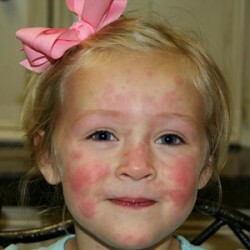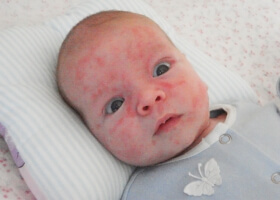Hives
 Urticaria is a skin disease of allergic origin very similar to a nettle rash, which was also called nettle fever. The disease worries the patient with itchy, raised light red blisters. The disease itself is either an independent allergic reaction to an irritant or a manifestation of almost any disease.
Urticaria is a skin disease of allergic origin very similar to a nettle rash, which was also called nettle fever. The disease worries the patient with itchy, raised light red blisters. The disease itself is either an independent allergic reaction to an irritant or a manifestation of almost any disease.
The disease appears due to acute inflammatory edema of the connective tissue of the papillary layer of the skin. A nettle rash likes to combine with Quincke's allergic swelling. At least once in a lifetime, every third person experienced life with this disease. In the structure of diseases of allergic origin, K. is immediately behind bronchial asthma. The most common are allergic rashes people from 20 to 60 years of age( mostly women)
Urticaria - the causes of
The reasons for this lie in the allergic reaction of the body to irritants, provocateurs can also be fungal or bacterial allergens, insect bites. Violation of the function of the liver, metabolism, gastrointestinal tract, kidneys can also cause the appearance of the disease. Often, chronic K. may appear after prolonged cold, heat, sunlight, pressure, viral diseases, antibiotics, aspirin and other medications taken. At present, the diagnosis and treatment of allergies is a serious problem, because all causes of hives are not fully understood. And the establishment of the root cause of allergic rash is the key to successful and effective treatment of
Urticaria - symptoms
The main symptom of urticaria is skin blisters on the body. In appearance, urticaria resembles a red trail, like after an insect bite or a burn left by the nettle. The main symptom of the disease is a rash. Rashes are symmetrical, asymmetrical, chaotic. They are plural, individual, small, large. Elements of the rash are able to arise and migrate to any places of the skin. Unpleasant incessant itching bothers at the site of the rash. The disease is characterized by reversibility of the elements and after the seizure of the attack, the integuments return to the original state.
Urticaria - forms
The following forms are distinguished from the duration of the disease and symptoms: acute, chronic, recurrent.
Acute K. is characterized by a duration of several hours to two weeks. It arises because of an allergic reaction to drugs, food, infections, and insect bites.
Chronic K. occurs with various pathologies and is often combined with Quinck's edema for up to several months. The disease is associated with impaired functions of the kidneys, liver, gastrointestinal tract, foci of chronic infection, toxicosis of pregnant women, disruption of malignant tumors. The misconception is that with the swelling of Quincke, only the face and throat are affected. This swelling can appear on the feet, hands, and also other parts of the body.
Recurrent K. is characterized by repeated occurrence of urticaria rash.
Urticaria is not a contagious disease and can not be transmitted from one person to another. With a fast-paced episode of illness, patients often do not seek help from doctors.
According to statistics, acute urticaria is more common in children, as well as in adolescents, but chronic K. occurs frequently in adults and mainly in women. The disease can be hereditary in nature and thus transmitted. Acute K. can go into chronic form, but not always, so do not rush to panic. In many patients with chronic K. recovery occurs in the first six months.
Is a hive dangerous? This is a myth that is greatly exaggerated. This is not a fatal disease and only the swelling of the throat, as well as anaphylactic reactions require attentive treatment. The disease itself can also disappear within 6 weeks to 12 months.
Causes of acute urticaria
Acute urticaria is inherently allergic and very hypersensitive due to an allergen, but despite this it can pass by itself.
Frequent allergens of acute cancer are drugs( penicillin, sulfonylamides), non-steroid drugs( aspirin), diuretics;Food products( eggs, peanuts, seafood, nuts, fish);Insect bites;Contact with allergens( latex, saliva of animals, plants);Application of radiocontrast substances;Acute infections, hormonal disorders, rheumatic diseases
Causes of chronic urticaria
In adults, the cause of chronic K. is still difficult to identify and often is of an autoimmune nature( a malfunction of the immune system), but in children chronic urticaria is detected much more often
Species of hives
Allocate spontaneous and physical( mechanical) K.
Physical( mechanical) urticaria is associated with physical factors and mechanical irritationSkin. Depending on these factors, dermographic urticaria, urticaria from pressure, solar, water, cholinergic, thermal, cold, contact, papular, vibrational, adrenergic K. are distinguished.
Dermographic urticaria is one of the forms of physical( mechanical) K. It is characterized by the appearance of blistersDue to friction or irritation on the skin with blunt objects, clothing.
Solar urticaria appears due to exposure to the skin of ultraviolet light - sunlight.
Aqueous( aquatic) urticaria appears from contact with water at any temperature. On the skin appear blisters, swelling, itchy.
Cholinergic urticaria occurs due to stimulation of sweating, as well as increased body temperature due to stress factors, physical activity, hot bath or stuffy room. The urticaria pattern acquires point blisters that spread over a larger surface of the skin, often accompanied by Quincke's swelling.
Thermal urticaria occurs due to direct contact of the diseased person with a warm or hot object.
Cold urticaria occurs from skin contact with a cold object, as well as staying in cold air or drinking cold drinks, food.
Papular urticaria happens due to insect bites( bed bugs, fleas, mosquitoes).The name for urticaria was due to a rash of "papules"( small skin nodules).
Adrenergic urticaria - arising from stress, a very rare disease that is characterized by a white rim around the blister without skin itching.
Chronic idiopathic urticaria is characterized by periodic exacerbation( mainly in women), but never identified cause.
Pigmented K. and mastocytosis are classified as diseases characterized by the accumulation of mast cells in tissues, organs.
Nervous( psychogenic) urticaria occurs due to stress and nervous experiences. Food urticaria is a hives invented by patients associated with the use of certain foods. Officially, such urticaria not, but if the person concerned bowel disease, kidney disease, the hives provoke the toxins that have been in the food and not withdrawn from the body 
urticaria
Diagnostics Diagnostics is engaged allergist-immunologist and definitively diagnosed after examination of the patient. Assumption of allergic K. recommended skin tests, the definition of antibodies of blood.
There are a number of diseases are very similar to urticaria: urticarial vasculitis, mastocytosis, atopic dermatitis, erythema multiforme, contact dermatitis, scabies, anaphylactoid purpura
Urticaria -
treatment How to cure hives within a short time? Unfortunately, a fast radical remedy for getting rid of this disease does not exist yet.
Treatment of urticaria in adults is fundamentally different from the treatment of urticaria in children.
The main methods of treatment in adults are antihistamines, immunomodulators.
Antihistamines are drugs treat both acute and chronic K. But immunomodulators( cyclosporine or prednisone) are recommended for patients with chronic K.
After examination of the patientphysician prescribed diagnostic tests, fasting from three to five days from the reception of 2 liters of water are recommended daily cleansing enemas, shower, easy physical charging. If there is a positive effect, then the rashes decrease and stop. Such dynamics are characterized by an allergic K. If symptoms remain, as well as progress, it indicates pseudoallergic K.
patients with allergic K. diets background begin conducting provocative tests with the introduction of the alleged food allergens. Special tests have been developed that allow to differentiate allergic as well as pseudoallergic K.
Treatment of acute urticaria
Is it possible to cure hives? In the treatment of acute C. it is difficult to combine it with Quinck's edema. If the rash small, it is possible to restrict antihistamines of the second generation drugs( Claritin, loratidine, fenistil, dimetenden et al.) Dosage 1 tablet 1 time per day, the dosage is increased if necessary. When the disease is aggravated with Quincke's edema, a group of adrenal gland hormones( GCS) is administered in the form of tablets, as well as injections at the physician's discretion. The dosage itself, as well as the duration of the use of medicines, is prescribed by a dermatologist or an allergist
Treatment of chronic urticaria
How to cure chronic urticaria? In the treatment of chronic K. identify a primary disease. The main drugs are second-generation antihistamines( claritin, loratidine, fenistil, dimetendene, etc.) in a usual dosage or increased at the doctor's discretion. The duration of treatment depends on the continuation of the symptoms of the disease
Diet for hives
It is erroneous to prescribe a hypoallergenic standard diet in all cases of rash. It is advisable to exclude from the diet of acute products K. those products which, according to the results of the research, cause an allergic rash. Patients with acute and chronic edema are advised not to drink alcohol
Nutrition for urticaria
What can I eat with urticaria? Displaying strict adherence to a diet in which there is restriction of fats, sugars, liquid salt, with the exception of chocolate, eggs, citrus fruits, smoked, sharp, giving up smoking and alcohol, as well as contact poisons gepatropnogo origin
Treatment of hives at home
YourselfTo start to treat an allergic rash is recommended only after survey by the doctor as there is a probability of danger angio-edema in the field of a throat. Recommended for the relief of the condition cleansing enema, abundant drink.
After examining the doctor and coordinated with the treatment, you yourself can take second-generation antihistamines( claritin, loratidine, fenistil, dimethendene).Be sure to show the doctor after the removal of the symptoms of the disease and to agree on further actions of treatment and prevention of rash.
You can wash with hives and even recommended a warm shower, a little exercise. After removing the exacerbation of the underlying disease should be every 3 months to repeat the four-week treatment of enzyme preparations hepatoprotectors Cholagogue and recommend annual treatment in sanatoriums
Urticaria in children - treatment
symptoms of urticaria in children is practically no different from an adult, but the expression of theirEmotions, children become listless, capricious, restless.
K. Treatment of child happens to the child, taking into account the weight, so the doctor selects children's doses of antihistamines Urticaria
in pregnant women - treatment
hives in pregnancy proceeds differently, so treatment requires an individual approach. In all cases, the benefit or possible harm to the baby is weighed. The safest drug for pregnant women is Loratadin.



